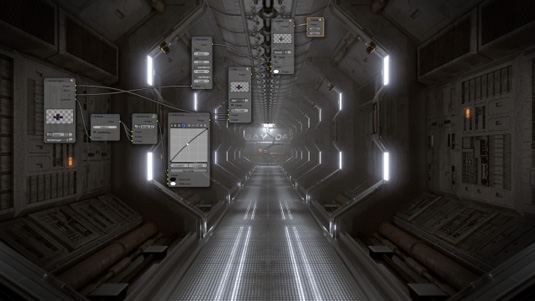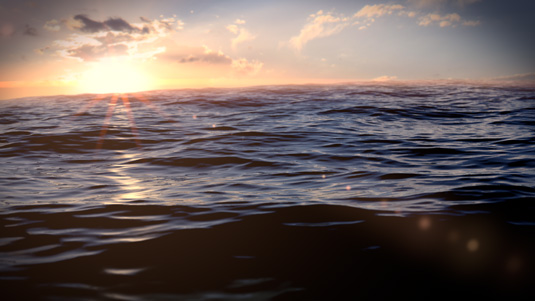Free 3D software: 10 things you didn't know you could do with Blender
If all you know about Blender is that it's free to download, maybe it’s time you took another look.
There's a number of free 3D software packages available to download online. One of the most popular is open source software Blender. Over the last few years, its development has really forged ahead and while many of its idiosyncrasies remain, there’s a lot of good stuff in there of use to CG artists and illustrators.
In fact, the software has come so far in recent years, that Blender enthusiasts all over the world are branching out into 3D movies, currently working on feature animation The Gooseberry project.
You can master the software with this brilliant selection of Blender tutorials. But before you do, read on for some interesting facts about Blender; some you might know, a few you probably won't - and a couple of things that took us by surprise too…
01. You can render with it

Of course you know you can create images with Blender, but did you know it has a GPU-accelerated unbiased render engine, called Cycles? As long as you have a CUDA-compliant graphics card, you’ll get realtime rendering in the main display.
Not only does this help Blender artists work more quickly and efficiently, but with Cycles' global illumination the images are much more photoreal. The latest version of Cycles is has an improved sky model, blackbody emissive materials, hair rendering and tone mapping - and the next one will feature volumetrics too..
02. You can simulate fluids

Yep, Blender also has a fluid simulation component (using the Lattice Boltzmann method if you must know), which you can use to make anything from splashing liquids to warm chocolate or oozing toothpaste. Fluids are part of Blender's Physics system, and generates a cached surface mesh as it simulates.
It's pretty basic, but is easy to set up and provides some niceties like Fluid Control to shape the substance (think The Abyss' watery pseudopod). It's not the most advanced fluid sim and certainly not the fastest, but for simple jobs or funky illustrations it'll do the job. Oh and Blender's physics can also generate smoke as well, using a voxel system.
Daily design news, reviews, how-tos and more, as picked by the editors.
03. It's a video editor
As well as enabling you to create and output CG, Blender is also a non-linear video editor. And even though it looks a little different to your Typical Premiere or Final Cut Pro set-up, all the tools are there and you can rearrange the layout to imitate one of the big-name NLEs.
Blender offers the usual video editing tools, allowing you to add clips or images to a timeline, make cuts and edits, add transitions, keyframe fades and so on. The graph editor lets you manipulate timings or audio levels, and when you're done you can export to a number of formats.
04. You can do compositing

So you've rendered all your CG, and now you'd like to sweeten the image in post. Well, Blender has that covered too, with an integrated node-based compositing system. The OpenCL-accelerated compositor allows you take the various render layers output from Blender and assemble them with control over the individual elements.
You can make subtle colour grades, apply flares and glows, add depth-of-field, or motion blur, and more. It's not going worry the makers of Nuke or After Effects any time soon, but it's useful if all you need is to combine your CG elements and add a little finesse.
05. It handles camera and motion tracking

Making cool CG is fine, but what about it you need it combined with live-action footage? Blender's camera tracker can help do that. Just like Boujou, SynthEyes, PF MatchIt et al, Blender will track markers or naturally-occurring features in your video clip, and reverse-engineer the camera's position.
It pumps this data to Blender's camera and then your CG can be seamlessly composited into the footage. It might not have the same high-end features as the big players but it does support object and planar tracking, and for most users it's absolutely ideal.
06. You can sculpt in it

ZBrush began a revolution in digital sculpting that has been emulated by the likes of Mudbox, Cinema4D, 3D-Coat and so on. Not to be left out, Blender has its own multi-resolution sculpting toolset, enabling you to add enormous amounts of organic detail to your models. It features 20 different sculpting brushes to push, pull, mould and carve your meshes.
And, not only that, but it also has a Dynamic Topology function, which, like Sculptris, adds extra geometry as you work, so you can doodle away without worrying about poly flow. It does begin to choke a little with high poly counts, where other apps still work smoothly, but for a free app, it's very impressive nonetheless.
07. You can simulate dynamics
Blender isn't alone in its use of the Bullet physics engine - you'll find it in Maya, LightWave, Modo, Cinema4D, etc - but its implementation is pretty substantial. As well as the usual object collisions, you have a range of constraints, so you can motorise components and make hinges, pistons, springs or chains of objects that can come apart during the simulation.
It also includes a fracturing system for breaking up meshes, interaction with forces such as wind, plus soft bodies for making jelly-like substances, rubber rings, elasticated objects, floppy body parts, etc. Oh and it also does cloth, for all your floppy fabric needs.
08. Make hairy characters
No self-respecting CG app doesn't have a hair system these days, and Blender is no exception. So rather than having fake it with alpha-mapped textures or loads of geometry, you can create hair fibres which are rendered using the Cycles engine. The hair is actually based on Blender's particle system, which creates splines determining where the hair fibres are drawn.
You can allocate particles to vertex groups, then cut, comb and style the guides, or use Blender's built-in dynamics to make the hair behave in a naturalistic fashion. And, in the right hands, the results are as good (if not better) than many apps costing thousands.
09. You can make an ocean

The surface of the Earth is two-thirds water, so it makes sense to have a dedicated ocean generator. Based on the open source Houdini Ocean Toolkit, it displaces a plane object, with control over the size and frequency of the waves, wind power and velocity and so on. You can then just render it in Blender, or you can use the exported displacement maps in an app of your choice.
But if you render in Blender you can also include normal maps for additional detail and a vertex map to generate animated foam on the wave crests. It's a simple system but works brilliantly.
10. There's a game engine built in

Okay, it might not be high on your list, but if you fancied dabbling with game design, Blender has that covered too. The OpenGL-based engine uses a graphical interface for building game behaviours without coding, features the Bullet physics engine for realtime collisions and interactions, and has support for vehicle dynamics.
The game engine is currently a separate project but there are plans to integrate it more closely, so it'll be less of a game engine, and more useful for things like interactive demos, arch viz walkthroughs and scientific sims. Of course, you can still build game prototypes, too, for that Kickstarter project…
Words: Steve Jarratt
Steve Jarratt is a freelance journalist covering CG art, technology, videogames and military history.

The Creative Bloq team is made up of a group of art and design enthusiasts, and has changed and evolved since Creative Bloq began back in 2012. The current website team consists of eight full-time members of staff: Editor Georgia Coggan, Deputy Editor Rosie Hilder, Ecommerce Editor Beren Neale, Senior News Editor Daniel Piper, Editor, Digital Art and 3D Ian Dean, Tech Reviews Editor Erlingur Einarsson, Ecommerce Writer Beth Nicholls and Staff Writer Natalie Fear, as well as a roster of freelancers from around the world. The ImagineFX magazine team also pitch in, ensuring that content from leading digital art publication ImagineFX is represented on Creative Bloq.




